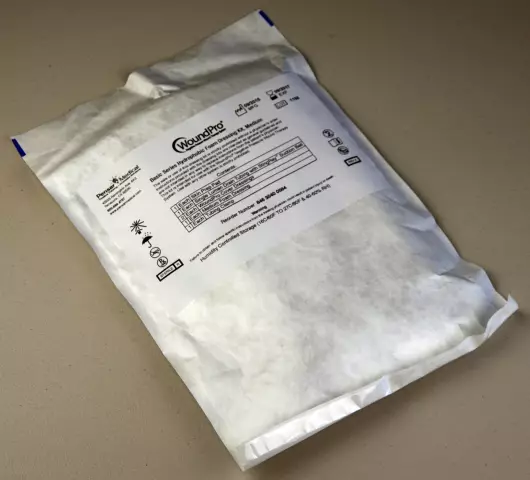- Author Curtis Blomfield [email protected].
- Public 2023-12-16 20:44.
- Last modified 2025-01-23 17:01.
Sometimes events happen in our lives that lead to disastrous consequences. The terrible sight of fractures, lacerations, severe bruises, bleeding is familiar to everyone. Anyone can fall into despair from it. However, most of these troubles are fixable. Mankind has accumulated a we alth of experience in dealing with such situations. A small part of this experience

is desmurgy.
Desmurgy
The section of medicine devoted to the rules for the use of dressings is called desmurgy. A bandage is a set of therapeutic agents that are applied to the patient's body for various diseases and injuries. In a narrow sense, the term bandage refers to the method of closing wounds or pathological changes in the skin surface. In this case, holding, pulling, fixing or pressure bandages are used. The complex of all actions for applying bandages is called dressing. In medicine, the most widely used so-called soft bandages. According to their purpose, they are divided into medicinal, immobilizing,protective, corrective and pressure bandages.
Medicinals
When applying a medicinal bandage to the affected area, medicines are applied in the form of an ointment, powder, gel or solution. Often, the material that will be in direct contact with the wound is also impregnated with the drug. An aseptic dressing is applied on top.

Defensive
Bandages of this type are used to prevent secondary infection of the wound and protect it from external influences. A simple version of this bandage is a conventional aseptic bandage. This also includes occlusive dressings and film-forming aerosols. Occlusive dressings are used to seal a body cavity, such as a penetrating chest injury.
Pressing
Compression bandages are used to stop bleeding. Apply them to the site of the damaged vessel. The technique of applying a pressure bandage consists in tightly wrapping the damaged area with a bandage. In this case, a gauze pad or a roll of bandage is applied to the wound site. The bandage must be tight. The imposition of a pressure bandage during bleeding occurs in alternately divergent directions. Bandage tours lie on top of a gauze pad with maximum density. The same dressing can be done with a muscle rupture. Pressure bandages can also be used to apply even pressure to the limbs. For varicose veins, for example, the legs are bandaged with an elastic bandage.
Immobilizing

Bandages of this type are used to fix various parts of the body. For example, the use of special knee pads in sports medicine to fix a damaged ligamentous apparatus. Also, an immobilizing bandage is applied to fix the damaged part of the body in order to transport the patient to a medical facility.
Corrective
This type of dressing fixes the body in a certain position for a long time. They are used to correct an acquired or congenital defect.






